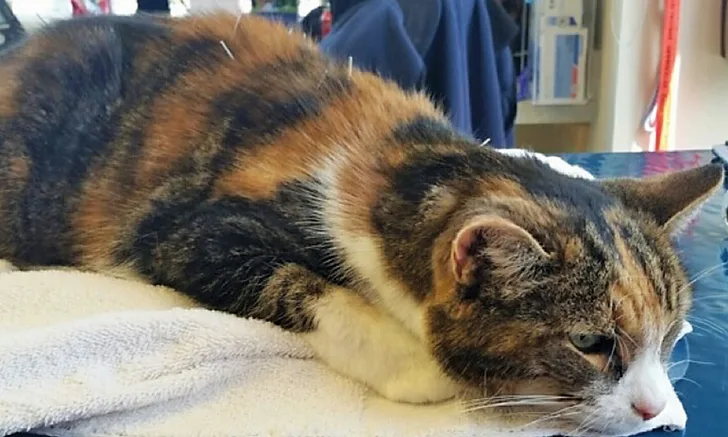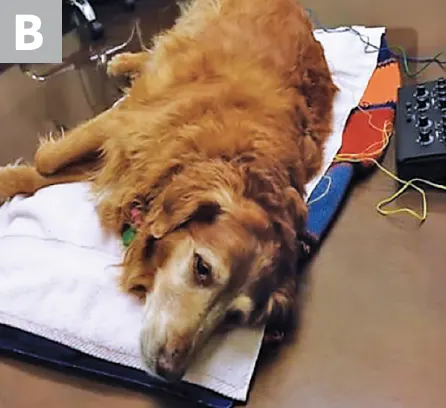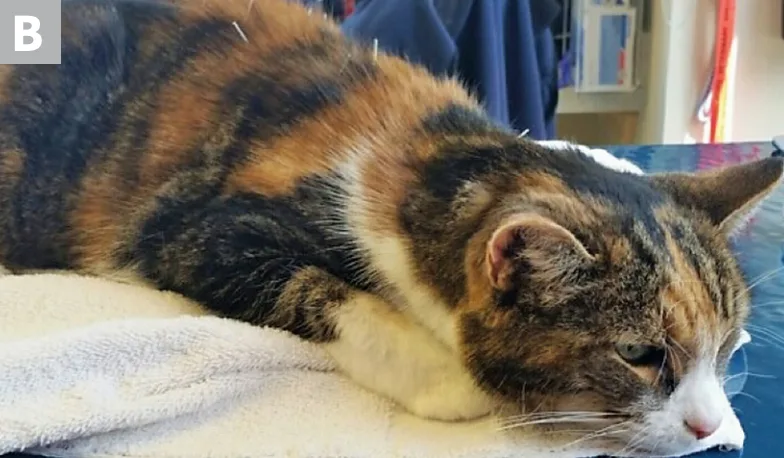Acupuncture to Support Veterinary Oncology Patients
Kathryn R. Vickery, VMD, MS, DACVIM (Oncology), Colorado State University

Complementary medicine has surged in popularity and acceptance among human healthcare physicians over recent decades.1 Complementary medicine refers to health and wellness therapies that have typically not been part of—but are meant to be used in conjunction with—conventional Western medicine. Studies have shown that some of these therapies, including acupuncture, may be beneficial for human cancer patients.2-9
Physicians are gaining confidence in the potential benefits of acupuncture for cancer care in humans.
In 1998, the National Institutes of Health published a consensus report summarizing research findings that confirmed the efficacy of acupuncture in alleviating chemotherapy-induced nausea as well as postoperative pain secondary to tumor removal in humans.2 This report sparked interest in acupuncture as a complement to Western medicine. Since publication of that report, there has been increased funding to support research evaluating the molecular mechanisms and clinical benefits of acupuncture for various diseases.3 As more positive research is published, physicians are gaining confidence in the potential benefits of acupuncture for cancer care in humans. It is therefore not surprising that top-tier, world-renowned US cancer institutes—such as Dana-Farber Cancer Institute, Memorial Sloan Kettering Cancer Center, and MD Anderson Cancer Center—now have integrative medicine programs that include acupuncture as part of their cancer-care programs.10-12
Some veterinarians are skeptical about the usefulness of acupuncture in animal patients; the most common argument is that scientific data are insufficient to demonstrate benefit. Although this may be true in veterinary oncology patients, data in the human literature support acupuncture as a beneficial adjunct therapy to traditional treatment for cancer patients.2-9 Applying what is known in human medicine to veterinary patients may spur further research to augment the scientific database and dispel skepticism.

Acupuncture needles are thin, sterile, and solid without a cutting edge. Needles typically range between 32- and 40-gauge and 0.25 to 1-inch in length. The acupuncture needles pictured (right 2 needles) are compared with a standard 22-gauge needle, which is most commonly used to draw blood.
Acupuncture Overview
Acupuncture comprises 3 key elements: acupuncture point (ie, acupoint), stimulating method, and therapeutic effect. Research has demonstrated that acupoints have high electrical conductivity and low electrical resistance and contain large numbers of arterioles, lymphatic vessels, nerve endings, and mast cells.13-16 The most common stimulating techniques involve a needle alone (Figure 1) or connected to low-level electricity (ie, electroacupuncture; Figure 2). As the acupoint is stimulated, peripheral and central neural pathways are modulated, leading to an effect on hormones, cytokines, neurotransmitters, and other chemical mediators in the body.17 Human and veterinary studies have shown acupuncture to be beneficial in alleviating pain4,5,18,19 and nausea7,16,18-21 and modulating the immune system and anti-inflammatory responses.6,20

An electroacupuncture unit is used to deliver low-level electrical stimulation to the acupoint. The leads are connected to the acupuncture needle on the patient.

Patient resting while receiving acupuncture treatment. Acupuncture needles are placed at acupoints.

Electroacupuncture lead is connected to the acupuncture needle.
G-CSF = granulocyte colony-stimulating factor
In a 3-armed, randomized, prospective clinical trial, women with high-grade mammary carcinoma who were treated with high-dose myeloablative chemotherapy were assigned to 1 of 3 groups: antiemetic alone, antiemetic with electroacupuncture, and antiemetic with acupuncture at a nontherapeutic location (ie, acupuncture needle is placed where a known acupoint does not exist) on the body.7 Women in the antiemetic with electroacupuncture treatment group had significantly fewer vomiting episodes as compared with women in the other groups.7
Another study investigated the effect of acupuncture on WBC count and absolute neutrophil count in ovarian cancer patients receiving myelosuppressive chemotherapy.9 Patients received either therapeutic acupuncture or nontherapeutic acupuncture while undergoing chemotherapy. Acupuncture was given 2 to 3 times per week starting 1 week before the second cycle of chemotherapy, for a total of 10 sessions. WBC count, absolute neutrophil count, and plasma granulocyte colony-stimulating factor (G-CSF) were assessed weekly for 1 month. The median WBC count in the therapeutic acupuncture group was significantly higher than in the nontherapeutic acupuncture group after adjusting for baseline value (8600 cells/μL [range, 4800-12 000 cells/µL] vs 4400 cells/μL [range, 2300-10 000 cells/µL]; p = 0.046). Additionally, the incidence of grade 2 to 4 leukopenia was less in the therapeutic acupuncture group than in the nontherapeutic acupuncture group (30% vs 90%; p = 0.02). The median leukocyte nadir, neutrophil nadir, and recovering absolute neutrophil counts were all higher but not significantly different after adjusting for baseline differences. There were no significant differences in plasma G-CSF between the groups. The clinically relevant trend of higher WBC values during 1 cycle of chemotherapy observed in patients with ovarian cancer that received therapeutic acupuncture during myelosuppressive chemotherapy suggests a potential myeloprotective effect of acupuncture.9
In light of the positive research findings, veterinarians may theorize that this modality may help support veterinary oncology patients. Chemotherapy is among the most common modalities used to treat cancer in veterinary patients. Most chemotherapy protocols for these patients are designed to result in hospitalization rates of <5% and mortality rates of <1%.22,23 These goals are accomplished by reducing dose intensity, usually via less frequent treatments, using single-agent protocols, or lowering doses of the chemotherapeutic agent.22,23 In theory, such adjustments may negatively affect treatment efficacy. Additionally, side effects (eg, GI upset, bone marrow suppression) still occur.22,23


FIGURE 3 (A and B) Cat with GI lymphoma receiving acupuncture treatment
In My Opinion …
Because of research demonstrating acupuncture’s benefits in alleviating cancer pain and nausea secondary to chemotherapy in humans, it can be theorized that acupuncture is beneficial in veterinary patients as well. Acupuncture may also help alleviate the severity and decrease the duration of side effects, thereby reducing the recovery and delay time between chemotherapy treatments. Furthermore, if acupuncture can reduce the risk for side effects, additional research should evaluate whether the dose intensity of chemotherapeutics may be increased to potentially improve tumor cell death and benefit overall treatment efficacy. The tumor itself may cause clinical signs that negatively affect overall quality of life and therefore decrease survival time (eg, gastroenteritis and poor appetite in a GI lymphoma patient [Figure 3], generalized pain in a lymphoma patient with osteoarthritis [Figure 4]). Veterinary studies demonstrate that acupuncture increases the production of ß-endorphin, an endogenous opioid, and helps reduce nausea.18,21

Dog with lymphoma and osteoarthritis receiving electroacupuncture treatment
Acupuncture may help support veterinary patients and improve their overall quality of life, resulting in potentially longer survival outcomes. To the author’s knowledge, there have been no published studies evaluating acupuncture for issues that may arise in veterinary oncology patients (eg, treatment- or tumor-induced side effects); this is an area of study with a great deal of potential.
It is important to note that acupuncture is not a cure-all. Both conventional Western medicine and acupuncture have their strengths and weaknesses. The ideal treatment is a combination of both to complement the strengths of each system.
The Discussion Continues...
Acupuncture: History & Application by Justin Schmalberg, DVM, DACVN, CVA, CVCH, CVFT
Evidence-Based Chinese Herbal Medicine by Kendra V. Pope, DVM, CVA, CVCH, CVFT, CVTP